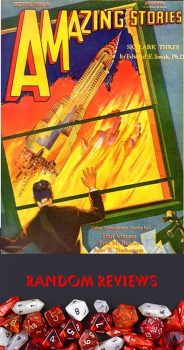Random Reviews: “The Troglodytes” by Fred M. Barclay

Fred M. Barclay had a story to tell, “The Troglodytes,” and he told it. Apparently, he said everything he had to say, because there is no indication that he ever published anything else. In Science Fiction: The Gernsback Years, Everett E. Bleiler’s biographical note on Barclay states, “No information.”
Barclay uses a framing technique that was relatively common at the time. His narrator, Joe Everett, is found disheveled by a family on a country road and when they take him in to make sure he is okay, he tells them the story of his adventure, which began with Joe and two of his friends, John and Jim. The three men found a cave and decided to explore it, discovering an ancient civilization living underground and completely divorced from the surface world.
It is clear from the start that John and Jim did not return to the surface world with Joe and the main tension is the story is what happened to them. An initial expectation that they were killed by the troglodytic race known as the Ampu appears to be subverted once the trio meets them. The Ampu are welcoming to them and treat them well, giving them a tour of their subterranean world, almost as if they were honored guests.
Much of the story is Barclay offering an almost utopian look at a world that has achieved gosh-wow levels of coolness in their technological advancements, although he makes no attempt to offer explanations for how they are able to sustain themselves in their subterranean world or how the science that powers their machinery could actually work. “The Trogolodytes” is a tour through Barclay’s world of wish fulfillment rather than an actual story.
His three main humans are established with differing personalities, even though they are friends and co-workers. Joe, the narrator who returns to the surface world is the least defined, playing a role subservient to John, even in his own retelling of their adventures. John was the most inquisitive and made the closest connections to the Ampu. While Joe was invited to tag along, John was invited to participate and appeared to form a relationship with one of the Ampu women. Jim, however, grew more antagonistic toward the Ampu as the story progressed, alienating himself from both the hosts and the humans he had arrived with.
Although mostly told from Joe’s point of view during his time among the Ampu, the framing device does intrude on the story at various times. Obviously, Barclay begins the story by describing how Joe came to tell the story and at the end, his listeners indicate that they have evidence that the story Joe told is the truth, but occasionally in the middle of the story, Barclay interrupts the narrative to have them briefly comment on something Joe has said.
Framing stories are relatively common in the fantasy fiction published in the early years when speculative fiction was being defined, in part to give the author a sense of plausible deniability about relating a made-up story. It appears in Edgar Rice Burroughs’ A Princess of Mars and was more recently used by Michael Moorcock in his Nomads of the Time Stream series. While the framing device allows the author to take some liberties, including providing a more ambiguous ending than a story told in the first person, it also serves to distance the story from the reader. Barclay does not take advantage of the possibilities of the framing device, so it only really serves to push the reader away from connecting to the story.
Originally appearing in the September 1930 issue of Amazing Stories, “The Troglodytes” has languished in obscurity until it was reprinted in 2020 in a small press e-book, Hollow Earth Tales, Volume 5.
 Steven H Silver is a nineteen-time Hugo Award nominee and was the publisher of the Hugo-nominated fanzine Argentus as well as the editor and publisher of ISFiC Press for 8 years. He has also edited books for DAW, NESFA Press, and ZNB. His most recent anthology is Alternate Peace and his novel After Hastings was published in 2020. Steven has chaired the first Midwest Construction, Windycon three times, and the SFWA Nebula Conference 6 times. He was programming chair for Chicon 2000 and Vice Chair of Chicon 7.
Steven H Silver is a nineteen-time Hugo Award nominee and was the publisher of the Hugo-nominated fanzine Argentus as well as the editor and publisher of ISFiC Press for 8 years. He has also edited books for DAW, NESFA Press, and ZNB. His most recent anthology is Alternate Peace and his novel After Hastings was published in 2020. Steven has chaired the first Midwest Construction, Windycon three times, and the SFWA Nebula Conference 6 times. He was programming chair for Chicon 2000 and Vice Chair of Chicon 7.
Yep, that’s a pretty obscure one! Thanks for reading it so I don’t have to! 🙂